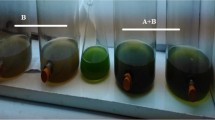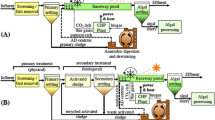Abstract
The present investigation was aimed towards analyzing the potential of consortia of native filamentous microalgal strains (MC2), native unicellular microalgal strains (MC3), and selected microalgae from germplasm (MC1) in terms of nutrient removal, water quality improvement, and biomass production using primary treated sewage water. Highest NO3-N (90 %) and PO4-P (97.8 %) removal was obtained with MC2-inoculated sewage water. Highest decrease in total dissolved solids to 806 from 1,120 mg L−1 and highest increase in dissolved oxygen of 9.0 from 0.4 mg L−1 were obtained using MC2-inoculated sewage water on the sixth day. The biomass production was also highest in MC2 (1.07 g L−1) followed by MC1 and MC3 (0.90 and 0.94 g L−1, respectively) on the sixth day. The consortium of filamentous strains from native environment not only proved promising in nutrient removal efficiency but also led to enhanced biomass. The present study highlighted the utility of such a consortium for sewage wastewater treatment and the promise of sewage water as a growth medium for biomass production.





Similar content being viewed by others
References
APHA (2005) Standard methods for the examination of water and wastewater. Port City Press, Washington DC, USA, pp 28–261
Aslan S, Kapdan IK (2006) Batch kinetics of nitrogen and phosphorus removal from synthetic wastewater by algae. Ecol Eng 28:64–70
Bhatnagar A, Bhatnagar M, Chinnasamy S, Das KC (2010) Chlorella minutissima—a promising fuel alga for cultivation in municipal wastewaters. Appl Biochem Biotechnol 161:523–536
Central Pollution Control Board (2009) Status of water supply and wastewater generation and treatment in class-I cities and class-II towns of India—a report by CPCB (2009). http://www.indiawaterportal.org
Chen L, Li T, Guan L, Zhou Y, Li P (2011) Flocculating activities of polysaccharides released from the marine mat-forming cyanobacteria Microcoleus and Lyngbya. Aquat Biol 11:243–248
Chinnasamy S, Bhatnagar A, Hunt RW, Das KC (2010) Microalgae cultivation in a wastewater dominated by carpet mill effluents for biofuel applications. Bioresour Technol 101:3097–3105
Cho S, Luong TT, Lee D, Oh Y, Lee T (2011) Reuse of effluent water from a municipal wastewater treatment plant in microalgae cultivation for biofuel production. Bioresour Technol 102:8639–8645
Doria E, Longoni P, Scibillia L, Iazzi N, Cella R, Nielson E (2012) Isolation and characterization of a Scenedesmus acutus strain to be used for bioremediation of urban wastewater. J Appl Phycol 24:375–383
El-Bestawy E (2008) Treatment of mixed domestic-industrial wastewater using cyanobacteria. J Ind Microbiol Biotechnol 35:1503–1516
Hori K, Si I, Ikeda G, Ji O, Tanji Y, Weeraphasphong C (2002) Behavior of filamentous cyanobacterium Anabaena spp. in water column and its cellular characteristics. Biochem Eng J 10:217–25
Komárek J, Anagnostidis K (2005) Cyanoprokaryota 2. In: Büdel B, Krienitz L, Gärtner G, Schagerl M (eds) Teil/2nd part: oscillatoriales. Süsswasserflora von Mitteleuropa. Elsevier, Heidelberg, pp 1–759
Komárek J, Fott B (1983) Chlorophyceae (Grün algen), Ordung: Chlorococcales. In: Huber-Pestalozzi G (ed) Das Phytoplankton des Süsswassers, Die Binnengewässer 16, 7/1. Schweizerbart Verlag, Stuttgart, pp 1–1044
Lichtenthaler HK (1987) Chlorophylls and carotenoids: pigments of photosynthetic biomembrane. Meth Enzymol 148:350–382
Mata TM, Melo AC, Simoes M, Caetano NS (2012) Parametric study of a brewery effluent treatment by microalgae Scenedesmus obliquus. Bioresour Technol 107:151–158
Markou G, Georgakakis D (2011) Cultivation of filamentous cyanobacteria (blue-green algae) in agro-industrial wastes and wastewaters: a review. Appl Energ 88:3389–3401
Molina Grima E, Belarbi EH, Acien Fernandez FG, Robles Medina A, Chisti Y (2003) Recovery of microalgal biomass and metabolites: process options and economics. Biotechnol Adv 20:491–515
Paerl HW (1986) Growth and reproductive strategies of freshwater blue–green algae (cyanobacteria). In: Sandgren CD (ed) Growth and reproductive strategies of freshwater phytoplankton. Cambridge University Press, Cambridge, UK, pp 261–317
Pittman JK, Dean AP, Osundeko O (2011) The potential of sustainable algal biofuel production using wastewater resources. Bioresour Technol 102:17–25
Rawat I, Kumar RR, Mutanda T, Bux F (2011) Dual role of microalgae: phycoremediation of domestic wastewater and biomass production for sustainable biofuels production. Appl Energy 88:3411–3424
Renuka N, Sood A, Ratha SK, Prasanna R, Ahluwalia AS (2013) Nutrient sequestration, biomass production by microalgae and phytoremediation of sewage water. Int J Phytoremed 15:789–800
Riano B, Molinuevo B, Garcia-Gonzalez (2011) Treatment of fish processing wastewater with microalgae-containing microbiota. Bioresour Technol 102:10829–10833
Round FE, Crawford RM, Mann DG (1990) The diatoms. Cambridge University Press, Cambridge, UK, pp 1–747
Silva-Benavides AM, Torzillo G (2012) Nitrogen and phosphorous removal through laboratory batch cultures of microalgae Chlorella vulgaris and cyanobacterium Planktothrix isothrix grown as monoalgal and as co-cultures. J Appl Phycol 24:267–276
Singh SK, Bansal A, Jha MK, Dey A (2012) An integrated approach to remove Cr (VI) using immobilized Chlorella minutissima grown in nutrient rich sewage wastewater. Bioresour Technol 104:257–265
Sood A, Uniyal PK, Prasanna R, Ahluwalia AS (2011) Phytoremediation potential of aquatic macrophyte, Azolla. Ambio 41:122–137
Starr RC, Zeikus JA (1993) UTEX—the culture collection of algae at the University of Texas at Austin. J Phycol 29 (Suppl):1–106
Sydney EB, da Silva TE, Tokarski A, Novak AC, de Carvalho JC, Woiciecohwski AL (2011) Screening of microalgae with potential for biodiesel production and nutrient removal from treated domestic sewage. Appl Energy 88:3291–3294
Wang L, Min M, Li Y, Chen P, Chen Y, Liu Y, Wang Y, Ruan R (2010) Cultivation of green algae Chlorella sp. in different wastewaters from municipal wastewater treatment plant. Appl Biochem Biotechnol 162:1174–1186
WHO and UNICEF Joint Monitoring Programme (2000) Global water supply and sanitation assessment report. New York: UNICEF and Geneva: WHO
Zhou W, Li Y, Min M, Hu B, Zhang H, Ma X, Li L, Cheng Y, Ruan R (2012a) Growing wastewater-borne microalga Auxenochlorella protothecoides UMN280 on concentrated municipal wastewater for simultaneous nutrient removal and energy feedstock production. Appl Energy 98:433–440
Zhou W, Min M, Li Y, Hu B, Ma X, Cheng Y, Liu Y, Chen P, Ruan R (2012b) A hetero-photoautotrophic two-stage cultivation process to improve wastewater nutrient removal and enhance algal lipid accumulation. Bioresour Technol 110:448–455
Acknowledgments
The first author is thankful to University Grants Commission, New Delhi, for her fellowship. All the authors are thankful to the Department of Botany, Panjab University, Chandigarh; Division of Microbiology, Indian Agricultural Research Institute, New Delhi; and University of Delhi, Delhi, for providing the budget and research facilities to carry out the present investigation.
Author information
Authors and Affiliations
Corresponding author
Electronic supplementary material
Below is the link to the electronic supplementary material.
ESM 1
(PDF 29 kb)
ESM 2
(PDF 18 kb)
ESM 3
Fig.S1 Growth kinetics of different microalgal consortia in standard growth medium (Bold’s Basal Medium) under outdoor conditions. MC1 (---▲---), MC2 (– –□– –), and MC3 (—◊—) are shown. Error bars indicate standard deviation (PDF 19 kb)
Rights and permissions
About this article
Cite this article
Renuka, N., Sood, A., Ratha, S.K. et al. Evaluation of microalgal consortia for treatment of primary treated sewage effluent and biomass production. J Appl Phycol 25, 1529–1537 (2013). https://doi.org/10.1007/s10811-013-9982-x
Received:
Revised:
Accepted:
Published:
Issue Date:
DOI: https://doi.org/10.1007/s10811-013-9982-x




